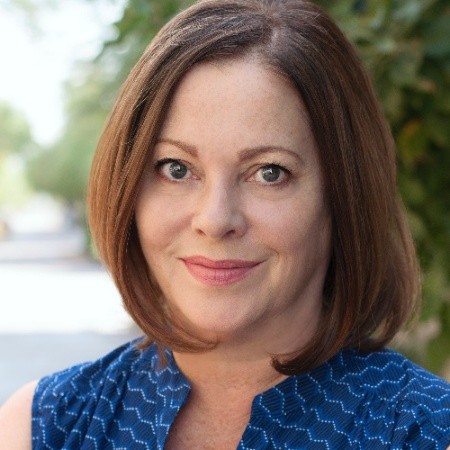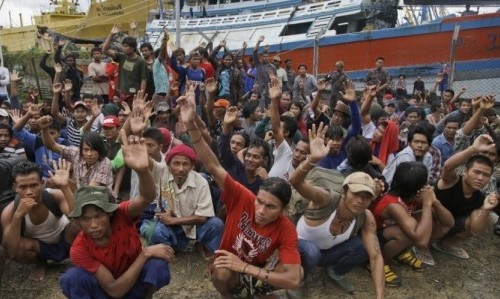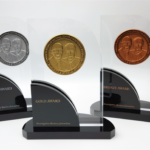The Associated Press’ Robin McDowell, Margie Mason, Martha Mendoza and Esther Htusan worked in four countries to investigate slavery in Southeast Asia’s fishing industry. Their in-depth reporting has led to the identification or repatriation of more than 2,000 men who were forced to work on trawlers in Indonesia. They also traced slave-caught fish making its way to plates in America. Their reporting earned them the 2015 Gold Barlett & Steele Award. Here’s how the team conducted their investigation.
It took nearly a year of reporting, networking and digging before McDowell in Yangon, Myanmar, and Mason in Jakarta, Indonesia, heard the first whispers about a remote Indonesian island village called Benjina, where hundreds of captive slaves were found.
From the Reporters: Slavery in Southeast Asia’s fishing industry had been an open secret for decades. Activists said the men were victims of some of the most severe abuses they had ever seen. NGOs and others who had looked most closely at labor abuses at sea warned us from the beginning. They said while there was little doubt slave-caught fish was ending up on American dinner tables, proving it was another matter.
The men were tricked, kidnapped or sold onto Thai fishing trawlers where they labored for months, sometimes years at a time. They were migrant workers from the poorest parts of Thailand, along with neighboring Myanmar, Cambodia and Laos who were issued fake seafarer documents that erased their identities. Many disappeared into international waters, losing all contact with the outside world.
Numerous stories had been written based on testimonies from men who managed to escape over the years, but what was less known was that their catch was transported from the open sea to Thailand for processing and then shipped worldwide as part of the country’s $7 billion annual seafood export business. Our reporting, combined with work from national writer Martha Mendoza in California, showed everything from the fake crab in your California roll to the food in your cat’s bowl could have been caught by slaves.
So how did we do it?
After months of chasing leads and trying to figure out the best way to connect the dots, stories of abuse were starting to filter out from Benjina, a little-known island village in far eastern part of Indonesia, just north of Australia. But because no outsiders had visited, it was impossible to know just how bad it was.
In November 2014, McDowell arrived to find men locked in a cage and a company graveyard filled with dozens of fishermen buried under fake Thai names. After realizing there were hundreds of captive slaves on the island, most of them from Myanmar, she called in Burmese reporter Esther Htusan from Yangon for help.
Once the men understood the AP was there to tell their stories, they opened up. A few wiped tears as they spoke. Some chased after the journalists on dusty paths, shoving pieces of paper into their hands with the names and addresses of their parents in Myanmar.
They said they were trapped, and forced to work the dangerous jobs at sea up to 22 hours a day. They were given unclean water, inadequate food and no medicine. They told stories of brutal beatings and bodies thrown overboard or stashed in their ships’ freezers. One man locked in the cage spoke through the bars into a camera sneaked in by a dockworker, saying the only thing he’d done wrong was ask to go home.
Some who managed to escape were living off the land for a decade or longer. As illegal migrants, they were too scared to go to authorities to ask for help, fearing they would be jailed or put back on ships. They felt cut off from the world because Benjina was unreachable for several months a year due to stormy seas. There were no roads or telephone service and electricity was only available a few hours a day.
The men took great risks to tell their stories. We also faced danger while reporting, including being chased by angry company officials on a boat.
It was an explosive story on its own, but it wasn’t enough. If it was going to have real impact, we needed more.
We used satellites to track a huge refrigerated cargo ship filled with slave-caught fish from Benjina to Thailand. From there, we climbed into the back cab of a pickup with tinted windows because we were repeatedly warned it wasn’t safe for journalists to be seen near the port run by a violent fish mafia. We stayed hidden for hours over four nights as we followed truck after truck of seafood being delivered to cold storage facilities, processing plants and the country’s largest seafood market.
After weeks of working to nail down that some of these smaller companies were selling to two major Thai exporting businesses, Mendoza started connecting the dots in the U.S.
She used U.S. Customs records to determine that tainted fish can wind up in the supply chains of some of America’s biggest stores including Wal-Mart, Kroger, Albertsons and Safeway, along with the nation’s largest food distributor, Sysco. It can also find its way into the supply chains of some of the most popular brands of canned pet food, including Fancy Feast, Meow Mix and Iams.
But even after we had all of this, we still could not run the story until we knew the slaves quoted and shown on camera in Benjina were safe.
Mason asked the International Organization for Migration to help, and they worked with Indonesian authorities to move the identified men off the island and into a secure shelter ahead of publication.
Just over a week after our story ran, the Indonesian government made a dramatic rescue, freeing more than 300 slaves from the island. Since then, nearly two years since our reporting began, more than 2,000 men have been identified or repatriated, arrests have been made, Thai cargo vessels have been seized in two countries, businesses have cut ties with tainted suppliers, Congressional hearings have been held, lawsuits have been filed and U.S. federal legislation has been written.
The impact has surpassed anything we ever could have imagined, but major problems still persist in the Thai and global seafood industries. Our investigation continues.










